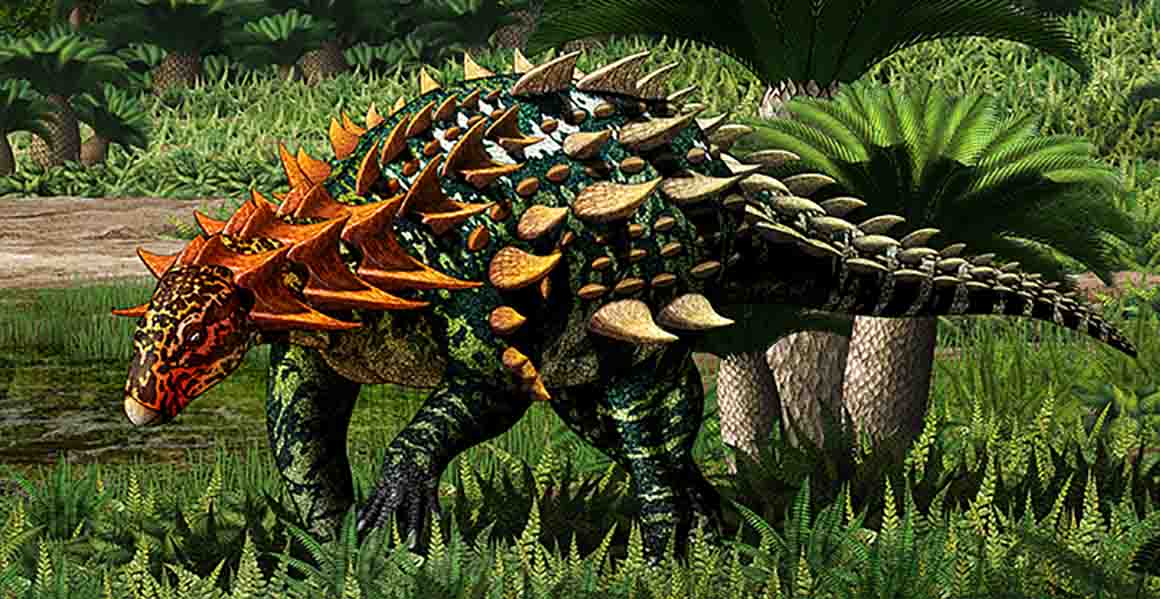Scientists from the Natural History Museum, Yunnan University, Yimen Administration of Cultural Heritage, the Chinese Academy of Sciences, the Center for Excellence in Life and Paleoenvironment, and Indiana University of Pennsylvania have described a new species of dinosaur from specimens found in Yunnan Province, China.

Reconstruction of Yuxisaurus kopchicki © Yu Chen
The new dinosaur is a thyreophoran, a group which also includes Stegosaurus and Ankylosaurus. Named Yuxisaurus kopchicki, it is the earliest well preserved armoured dinosaur found in Asia to date, living around 192–174 million years ago during the Early Jurassic. The discovery of the dinosaur confirms the rapid geographic spread and diversification of this group of dinosaurs after its first appearance around 200 million years ago.
Yuxisaurus kopchicki had a heavy build, distinctive spiked armour and numerous unusual features of its skull, particularly with respect to the bones that would have originally surrounded its brain.
The remains of the species consist of a single incomplete skeleton, including parts of the skull, jaws, vertebral column, shoulder girdle, limbs and large numbers of armour spines and plates.
Professor Paul Barrett, Merit Researcher at the Natural History Museum and first author on the paper, said: ‘Although we’ve had tantalizing fragments of early armoured dinosaurs from Asia, this is the first time we’ve had enough material to recognize a new species from the region and investigate its evolutionary history. I hope it’s the first of many new dinosaurs from the localities being discovered by my colleagues in Yunnan.’
Prof. Barrett and his colleagues described the new species, naming it Yuxisaurus kopchicki: Yuxisaurus referring to the discovery site in Yuxi Prefecture, China, and kopchicki after molecular biologist Dr John J. Kopchick in recognition of his contributions to biology and the Indiana University of Pennsylvania Science Building.
Dr Shundong Bi, a professor at Indiana University of Pennsylvania and senior author on the paper, said: ‘Yuxisaurus was possibly a facultative quadrupedal. It was primarily adapted for walking on four legs, but also able to walk on two legs.’
The study A new early-branching armoured dinosaur from the Lower Jurassic of southwestern China is published in eLife. It can be accessed here.
Notes to editors
Natural History Media contact: Tel: +44 (0)20 7942 5654 / 07799690151 Email: press@nhm.ac.uk
Images and paper available to download here.
The Natural History Museum is both a world-leading science research centre and the most[1]visited natural history museum in Europe. With a vision of a future in which both people and the planet thrive, it is uniquely positioned to be a powerful champion for balancing humanity’s needs with those of the natural world.
It is custodian of one of the world’s most important scientific collections comprising over 80 million specimens. The scale of this collection enables researchers from all over the world to document how species have and continue to respond to environmental changes - which is vital in helping predict what might happen in the future and informing future policies and plans to help the planet.
The Museum’s 300 scientists continue to represent one of the largest groups in the world studying and enabling research into every aspect of the natural world. Their science is contributing critical data to help the global fight to save the future of the planet from the major threats of climate change and biodiversity loss through to finding solutions such as the sustainable extraction of natural resources.
The Museum uses its enormous global reach and influence to meet its mission to create advocates for the planet - to inform, inspire and empower everyone to make a difference for nature. We welcome over five million visitors each year; our digital output reaches hundreds of thousands of people in over 200 countries each month and our touring exhibitions have been seen by around 30 million people in the last 10 years
Contact
Weekdays: +44 (0)20 7942 5654
Evenings and weekends:
+44 (0)7799 690 151
Email: press@nhm.ac.uk
Don't miss a thing
Receive email updates about our news, science, exhibitions, events, products, services and fundraising activities. We may occasionally include third-party content from our corporate partners and other museums. We will not share your personal details with these third parties. You must be over the age of 13. Privacy notice.
Follow us on social media